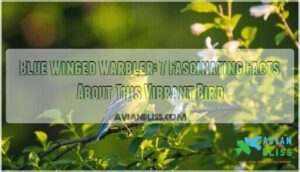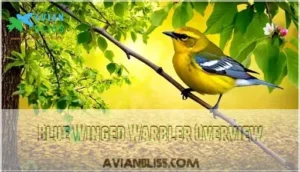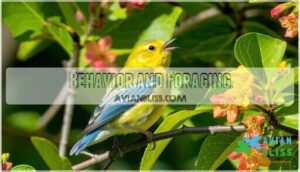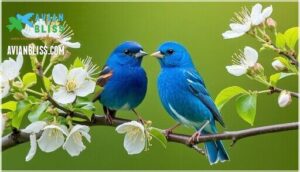This site is supported by our readers. We may earn a commission, at no cost to you, if you purchase through links.

This compact 4.5-inch songbird weighs just 0.3 ounces and sports a sleek black eye mask that makes identification straightforward.
They thrive in forest edges and shrubland areas, preferring intermediate zones between woodlands and open spaces.
During migration, these remarkable birds travel thousands of miles from eastern North America to Central and South American wintering grounds.
Their thin, pointed bills perfectly suit their insect-catching lifestyle, while their striking color pattern sets them apart from other warbler species.
Understanding their unique behavioral patterns and habitat preferences reveals surprising insights about their survival strategies.
Table Of Contents
- Key Takeaways
- Blue Winged Warbler Overview
- Habitat and Distribution
- Behavior and Foraging
- Nesting Behavior
- Conservation Status
- Frequently Asked Questions (FAQs)
- Are blue-winged warblers rare?
- Where is the Blue-winged Warbler?
- What is the nest of the Blue-winged Warbler?
- Why are blue-winged warblers expanding their home ranges?
- Where does the Blue-winged Warbler live?
- Are blue-winged and Golden-winged Warblers the same species?
- What is a yellow warbler with blue wings?
- What is the difference between a Brewster and a Lawrence warbler?
- What is the average lifespan of the warbler?
- What predators threaten the Blue-winged Warbler?
- Conclusion
Key Takeaways
- You’ll identify them instantly by their bright yellow head and body paired with blue-gray wings featuring two white wing bars, plus that distinctive black eye mask that makes them unmistakable among warblers.
- You’ll find them in transitional habitats like forest edges, shrublands, and overgrown fields where they thrive in the "in-between" spaces that many other birds avoid.
- You’ll witness incredible migration journeys as these tiny 0.3-ounce birds travel thousands of miles from eastern North America to Central and South American wintering grounds twice yearly.
- You’ll need to support conservation efforts because they’re facing serious threats from hybridization with Golden-winged Warblers and habitat loss, particularly in areas where forests are replacing their preferred shrubland environments.
Blue Winged Warbler Overview
You’ll easily recognize the Blue-winged Warbler by its bright yellow body and distinctive blue-gray wings with two white wing bars.
This small songbird measures just 4.5 inches long and features a black eye line that looks like a sleek mask across its face.
Physical Characteristics
You’ll spot blue winged warblers by their compact sparrow-sized frame measuring just 4.5 inches long.
Their bright yellow forehead catches your eye first, contrasting beautifully with bluegray wings adorned with two crisp white wing bars.
The thin pointed bill helps them snatch insects from branches while weighing only 0.3 ounces—lighter than most coins in your pocket, making them incredibly lighter.
Identification Features
You’ll recognize this blue winged warbler by its striking plumage patterns that make warbler identification straightforward.
Look for bright yellow feather colors on the head and underparts contrasting with blue-gray wing bars. The distinctive black eye masks create a sleek appearance, while the thin, pointed beak shape is perfect for insect catching.
These warbler characteristics help distinguish it from other bird species identification challenges you might encounter. Understanding the blue winged teal characteristics can also aid in recognizing similar species and their unique features, which is key to successful bird species identification and understanding the importance of warbler identification.
Habitat Preferences
Blue-winged Warblers thrive in nature’s "in-between" spaces where freedom meets structure.
These warbler habitat specialists seek transitional zones where open woodlands blend with shrubby areas.
Their preferred environments include:
- Forest edges with dense understory
- Abandoned farmland recovering naturally
- Shrubland ecology systems
- Areas with recent ecological disturbance
- Young forests with thick vegetation
Habitat preservation efforts focus on maintaining these dynamic landscapes that support bird habitat preferences.
Habitat and Distribution
You’ll find Blue-winged Warblers across eastern North America during breeding season, from the Great Lakes to southeastern states.
These birds prefer open woodlands, shrubby fields, and overgrown pastures before migrating to Central America for winter.
Breeding Grounds
During breeding season, you’ll find these warblers claiming territories across eastern North America.
Males establish breeding grounds in shrubby fields and forest edges, performing elaborate courtship displays and territorial marking through their distinctive "bee-buzz" songs.
Breeding habits include selecting nesting sites in dense understory vegetation, while mating rituals involve flight displays and aggressive defense of prime warbler habitat.
| Habitat Type | Elevation Range | Territory Size |
|---|---|---|
| Shrubby fields | 0-1,500 feet | 0.5-1 hectare |
| Forest edges | 200-1,200 feet | 0.3-0.8 hectare |
| Abandoned farmland | 100-800 feet | 0.4-1.2 hectare |
| Regenerating clearcuts | 300-1,000 feet | 0.6-1.5 hectare |
Wintering Grounds
When these warblers escape their breeding territories, they set out on incredible journeys to tropical havens.
These tiny adventurers journey thousands of miles to reach their tropical winter paradise
Winter migration takes them thousands of miles south to Central America and northwestern South America. These feathered wanderers find refuge in diverse landscapes that mirror their summer preferences.
Bird migration patterns lead Blue-winged Warblers to these five winter sanctuaries:
- Tropical forests in southern Mexico provide abundant insect prey
- Second-growth woodlands offer perfect foraging opportunities
- Shrublands across Guatemala and Honduras shelter migrating flocks
- Coffee plantations create ideal habitat corridors
- Dense scrublands in Panama support warbler migration routes
Bird conservation efforts now focus on protecting these critical winter habitats throughout their range.
Migration Patterns
You’ll witness these warblers undertake remarkable seasonal movements spanning thousands of miles.
Their bird migration routes stretch from eastern North America to Central America, with stopover habitats essential for refueling.
Climate impacts increasingly affect warbler migration timing, while their expanding hybridization range overlaps with Golden-winged Warblers during these epic bird migration patterns across diverse bird stopover sites.
These birds rely on visual landmarks to navigate during their long journeys, utilizing visual landmarks and facing climate impacts that affect their migration timing.
Behavior and Foraging
You’ll find Blue-winged Warblers hopping through dense shrubs and low branches, constantly searching for their favorite snacks of caterpillars, spiders, and small insects.
These energetic birds use quick darting movements and brief hovering flights to snatch prey from leaves, while males defend their territory with their distinctive buzzy "bee-buzz" song.
Diet Composition
Caterpillars fuel these energetic insectivorous birds throughout breeding season.
Their diet consists almost entirely of insects and spiders, with leaf-roller moth caterpillars making up the majority.
You’ll find them targeting beetles, ants, grasshoppers, and flies for maximum nutrient intake.
This specialized insect foraging makes them excellent natural pest controllers.
Their feeding habits adapt to local food sources, ensuring consistent prey capture across different habitats and seasons.
The Blue-winged Warbler’s insect-like buzzy bird song patterns are a key aspect of its behavior and communication.
Foraging Techniques
You’ll spot these insectivorous birds using dynamic foraging strategies that showcase their hunting methods perfectly.
They hover briefly while gleaning insects from leaves, then dart quickly to capture prey mid-flight.
Their feeding behavior focuses on caterpillars, spiders, and small insects found in low vegetation.
These food sources require precise insect capture techniques, making their warbler ecology fascinating to observe in avian ecology studies.
The birds’ ability to catch insects efficiently is related to effective insect catching tools, which is a key aspect of their insectivorous nature.
Territorial Behavior
During breeding season, you’ll witness fierce territorial behavior in Blue-winged Warblers.
Males establish territories through territorial songs and aggressive flight displays.
These nest guardians engage in border disputes with neighboring males, defending prime habitat associations.
Their warbler behavior includes mate defense strategies that involve chasing intruders away from nesting areas.
This avian ecology showcases how bird territory boundaries shape breeding success through determined territorial behavior.
Nesting Behavior
You’ll find Blue-winged Warblers building their nests close to the ground in thick vegetation for protection from predators.
These small birds construct cup-shaped homes using grasses, leaves, bark strips, and other natural materials they gather from their surroundings, which provides them with protection.
Nest Placement
You’ll find Blue-winged Warblers choosing ground nests or shrub placement with remarkable precision.
These warblers favor nest location sites that offer natural camouflage strategies, typically positioning their homes at the base of trees or within dense vegetation.
Ground-level nesting provides excellent protection from predators while maintaining easy access to foraging areas.
Their groundlevel nesting approach demonstrates smart bird nesting behavior, as females select spots in thick shrubs or overgrown fields where the nest remains hidden from view.
The construction of a Warbler Nest often involves nest building materials, which is a crucial aspect of their nesting process.
Nest Description
Using rootlets, grasses, bark strips, and moss, you’ll discover these warblers craft sturdy cup-shaped nests with remarkable precision.
The nest materials create a cozy refuge lined with fine hair and soft plant fibers. This cup depth reaches about two inches, providing perfect egg protection.
Their nest camouflage blends seamlessly with surrounding vegetation, making detection nearly impossible for predators seeking vulnerable breeding territories.
Understanding the importance of proper nest building techniques, such as those related to bird behavior nest, is essential for the survival of these birds.
Nesting Facts
Blue winged warbler females create fascinating nesting rituals during breeding season.
Nest placement occurs low in shrubs or ground level within dense vegetation. These cup-shaped structures use nest materials like grasses, leaves, and bark strips.
Egg laying produces 3-6 white eggs with brown spots. The incubation period lasts 10-12 days before the fledgling stage begins.
The fledgling stage begins, supporting warbler conservation efforts.
Conservation Status
You’ll find that Blue-winged Warblers face serious conservation challenges today. Their habit of hybridizing with Golden-winged Warblers threatens both species’ genetic integrity and long-term survival.
Hybridization Risks
Hybridization presents a growing threat you should understand.
These colorful warblers face extinction through genetic mixing with their golden cousins
Blue-winged Warblers increasingly interbreed with Golden-winged Warblers, creating Brewster’s and Lawrence’s warbler hybrids in expanding hybrid zones.
This genetic impact threatens species integrity, particularly for Golden-winged populations.
Avian hybridization affects breeding patterns and reduces pure populations by over 50% in some regions.
These bird hybrids complicate warbler species identification and require targeted conservation efforts to protect genetic diversity.
Understanding bird hybridization is essential for developing effective conservation strategies.
Habitat Preservation
Conservation efforts focus on preserving and managing shrubland habitats that Blue-winged Warblers desperately need.
You’ll find wildlife conservation groups working to maintain ecological balance through strategic habitat management. They’re preventing forest regrowth in key breeding areas while promoting ecosystem restoration projects.
Avian habitat conservation initiatives target warbler habitats specifically, creating corridors between fragmented landscapes. These ecological conservation programs help guarantee these vibrant birds won’t lose their homes to development.
Effective bird conservation requires understanding bird habitat preservation methods to protect warbler populations, which is crucial for their ecological balance and conservation.
Population Trends
Recent studies reveal mixed population trends for your review. While overall numbers remain stable, regional shifts paint a complex picture.
Key Population Trends:
- Northward expansion – Range extending into New England and southern Canada since 1970s
- Regional decline – 19% decrease in Virginia (2000-2020) due to habitat loss
- Hybrid zones shifting – Species hybrid events with Golden-winged Warblers affecting genetic integrity
- Migration patterns changing – Breeding population index shows 2.8% annual increase in core areas
Population decline occurs mainly where mature forests replace shrublands. Bird population dynamics show warbler population monitoring reveals concerning trends in Appalachian regions.
Avian population conservation efforts focus on maintaining bird conservation status through habitat management.
Frequently Asked Questions (FAQs)
Are blue-winged warblers rare?
Blue-winged Warblers aren’t rare overall. You’ll find them thriving across eastern North America, though they’re declining in some northeastern areas due to forest regrowth and urban development pressures.
Where is the Blue-winged Warbler?
You’ll find these songbirds throughout eastern North America during breeding season, from the Great Lakes to southeastern states.
They prefer shrubby fields, forest edges, and overgrown pastures before migrating to Central America, specifically to Central America.
What is the nest of the Blue-winged Warbler?
Imagine discovering nature’s hidden nursery—you’ll spot their ground-level nest tucked in dense shrubs.
Built from grasses, leaves, and bark strips, it’s cunningly camouflaged near tree bases.
This cup-shaped creation holds three to six speckled eggs.
Why are blue-winged warblers expanding their home ranges?
You’ll see these birds expanding their ranges because forest clearing by European settlers created perfect shrubby habitats. They’re thriving in abandoned farmlands and overgrown fields that didn’t exist before.
Where does the Blue-winged Warbler live?
Like a nomad following the seasons, you’ll discover these warblers breeding across eastern North America from Great Lakes to southeastern states, then wintering in Central America’s tropical forests and shrublands.
Are blue-winged and Golden-winged Warblers the same species?
No, Blue-winged and Golden-winged Warblers aren’t the same species.
They’re distinct species that hybridize, creating Brewster’s and Lawrence’s Warbler offspring.
You’ll find them interbreeding where their ranges overlap, but they maintain separate genetic identities, which is a key factor in understanding their distinct species status.
What is a yellow warbler with blue wings?
You’re looking at a Blue-winged Warbler.
These sparrow-sized songbirds measure just 5 inches yet migrate incredible distances to Central America annually.
They sport bright yellow bodies with distinctive blue-gray wings and white wing bars, plus that characteristic black eye line that looks like nature’s perfect eyeliner.
What is the difference between a Brewster and a Lawrence warbler?
Brewster’s Warblers show white underparts with yellow wing patches, while Lawrence’s Warblers display bright yellow underparts with white wing bars.
Both result from Blue-winged and Golden-winged Warbler crossbreeding, creating these distinct hybrid forms.
What is the average lifespan of the warbler?
Average warbler lifespan runs about 5 years in the wild, but you’ll occasionally find exceptional survivors reaching seven to nine years.
Though rare cases show birds living up to 9 years, most don’t survive beyond their third birthday.
What predators threaten the Blue-winged Warbler?
Danger lurks everywhere for these tiny yellow birds.
You’ll find domestic cats, snakes, and raccoons hunting their ground nests, while hawks and owls strike from above during daylight and nighttime hunts.
Conclusion
Absolutely nothing compares to the blue winged warbler’s extraordinary adaptability across diverse ecosystems.
You’ve discovered how this remarkable species navigates complex environmental challenges through specialized foraging techniques and strategic habitat selection.
The blue winged warbler demonstrates remarkable resilience despite facing hybridization pressures and habitat loss.
You can support conservation efforts by maintaining shrubland habitats and participating in citizen science projects.
These vibrant birds continue thriving through their efficient insect-hunting abilities and flexible nesting strategies.
Their success depends on preserving the forest edge environments they require for breeding and foraging throughout their range.








